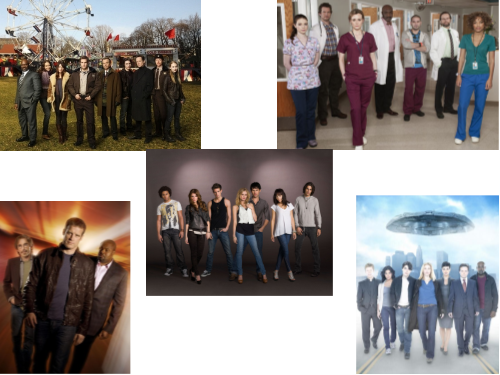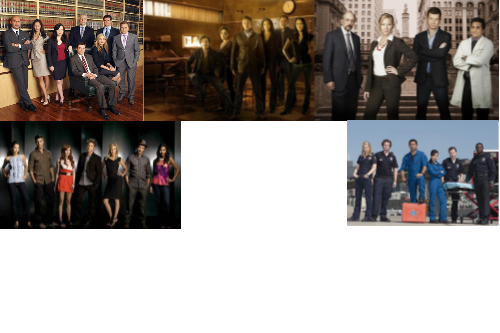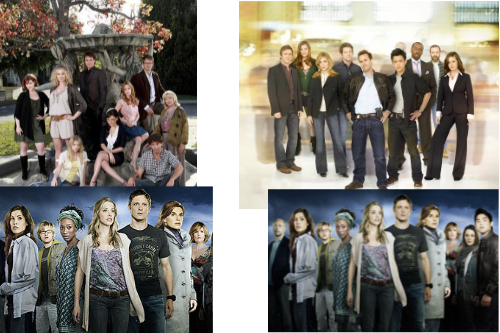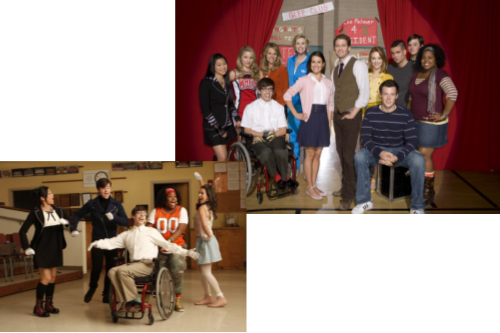Black Guy Corner: What the Upfront Photos Say about the State of TV
Cindy Conaway and Sheila Marie Aird/ SUNY Empire State College

Each year, television networks distribute photos to promote new shows for the upcoming season at conventions commonly known as the “Upfronts.” The five major television networks provide these photos to critics, advertisers, and websites that promote the industry. This article, part of a three-part series on race and television, examines the photographs used to promote hour-long television shows for the 2009-2010 season and their cultural significance, particularly pertaining to race. The season is ended, and many, in fact most, of the shows have canceled, turned into short-run miniseries, or never aired at all. Some actors were replaced before the pilots aired. This series deals only with what the photos themselves mean, and not with the programs’ content, successes, or failures. In future installments, we plan to consider substantial differences in 2010-2011 season’s promotions, how we determined who “counted” and issues involved with the contested notions of beauty and race, class and target audiences, and what increasing numbers of mixed-race and South Asian actors might mean to American (and globalized) culture.
People of color, particularly African American men in the promotional photographs are frequently off to the sides in what we dub “Black Guy Corner.” We noticed their marginalization by accident, and this changed our research focus. As cultural studies critics, “counting” is not something we generally do, but counting seemed to be the best way to start to answer our original question, which was simply, “How many characters of color are in the upcoming shows?” We wanted to know because there had been a fair amount of casting actors of color on big ensemble shows like Lost (NBC) and Heroes (NBC) in earlier seasons; however, as these shows progressed, African American men seemed to have short shelf lives.1 We saw two alternatives. It seemed as if that the networks might be fairly conservative in the 2009-2010 season, trying desperately not to alienate upscale audiences despite economic meltdown and the threat to broadcast television from online viewing. Conversely, the Obama election might have made them more open to casting more characters of color, particularly African-American men, in important roles. However, once we started looking at the photos as a group, we realized something problematic was happening.2
We had questions about what these pictures said about race relations in the United States. Does the television industry promote an agenda through imagery that maintains positions of power, or does it covertly use images to give primacy, or not, to a particular group of people? We questioned whether the photographs demonstrate racism, whether conscious or not, premeditated or not, beyond that systematically practiced by Hollywood for decades. Without reading beyond the short descriptions of the shows, or knowing who the “stars” are (since cast names were not “keyed” to the photos), what would a potential viewer of prime time television dramas think about the status of African American, Latina/Latino, and Asian American characters and actors on television today? Why and how should it matter?

Photos, clockwise from left: ABC’s Happy Town, featuring Robert Wisdom at far left; NBC’s Mercy, featuring Delroy Lindo, back center, Guillermo Diaz, third from right, Jaime Lee Kirchner, far right; ABC’s V including Lourdes Benedicto, second from left, and Morena Baccarin, third from right; Fox’s Human Target, Chi McBride at right; and CW’s A Beautiful Life, featuring Corbin Bleu at far left.
From these photographs, it is obvious that African American men were strategically placed to the back and/or side of the cast photos, even, as with Derek Luke of Trauma, when they were among the stars of their shows, or when they were arguably among the most famous people on their programs, like Corbin Bleu (of the High School Musical movies) on The Beautiful Life. Even when, as in the case of Mercy, an African American man is not at the far edges of the photo, he is still standing behind other characters.
Our theory is the networks believe African American men might not appeal to advertisers, critics, and potential viewers they want to attract, and found it advantageous to keep them in the background. A significant number of the African American men in these photos (including Robert Wisdom of Happy Town and Chi McBride of Human Target) also appear to be the oldest in the casts, seeming like friendly advisors to the mainly younger lighter-skinned cast, neither sex objects or threatening.
There was only one Latino man in the photos (in Mercy). One actor (Cliff Curtis of Trauma) is Maori. African American and Latina women could be close to center but not at center. Asians, including an increasing number of South Asians, could be either at center, close to center, or at the extreme ends of the photos. Most photos had a white man or woman, at the center.

Clockwise from left: ABC’s The Deep End, Sherri Saum, second from left; ABC’s The Forgotten, Reiko Aylesworth, second from left, Rochelle Aytes, third from right; Fox’s Past Life, Ravi Patel far right; NBC’s Trauma, Cliff Curtis, third from left, Aimee Garcia, third from right, Derek Luke, far right; CW’s Melrose Place, Stephanie Jacobson, far left, Jessica Lucas, far right.
It appears that these photos suggest a semiotic hierarchy of characters, with whites at the forefront, Asian Americans making strides toward the center, Latinas/Latinos still somewhat suspect, particularly men, and African Americans getting a few seats at the table, with African American men mostly relegated to the sidelines. These pictures might give the impression that “others” are less important or desirable in the dominant culture. If, despite the purported great strides made by people of color in real life, they are still marginalized in these photos, and presumably on these shows, it matters because networks and advertisers make choices based on what they think viewers will like and tolerate. We hypothesize the positioning is based on perceived “threat level,” with Asians and women being considered more attractive and less frightening than African American men to the networks’ more coveted audiences.
Critical race theory says that “racism is an ingrained feature of our landscape, it looks ordinary and natural to persons in the culture. . . . that invariably renders black and minorities one-down,” and that “a culture constructs its own social reality in ways that promote its own self interest” (Delgado and Stefancic xvii). Each of these promotional devices is more than just a photograph, and more than just an advertisement. Rather, reflects societal norms and the members of the dominant culture’s positioning themselves in relation to others. Although the photos are in plain sight, what they imply is not. The underlying message is blatant, latent, and subliminal.

Clockwise from upper left: ABC’s Eastwick, Lindsay Price, center; ABC’s Flash Forward, Courtney B. Vance, third from right, John Cho, fourth from right; NBC’s Day One as we originally saw it on zap2it.com; NBC’s Day One (replaced the next time we looked), April Grace, third from left, Derek Mio, far right.
Things have not changed as much as it might appear they have in the last decades, despite a marked increase in the sheer numbers of characters of color on screen. In 1999, after what a Slate article called “1999’s infamously ‘whitewashed’ primetime season, in which not a single freshman show had a leading minority character” (Rastogi), the NAACP issued a report critical of the lack of people of color both in front of and behind the camera, challenging the networks to increase representation, which they attempted to do. The networks added more characters of color to shows during the next decade and there have been many more than before the report, in terms of sheer numbers, but they are not necessarily given as much screen time or prestige as white characters. Current NAACP president Benjamin Todd Jealous asserted the most recent update to that report in 2008, Out of Focus, Out of Sync, Take Four, that the state of representation of people of color on TV was still not where it needs to be, stating, “At a time when the country is excited about the election of the first African-American president in US history, it is unthinkable that minorities would be so grossly underrepresented on US television” (Jealous, 2008). Yet, it is clear there is not really equality at the networks.
When we originally saw the photos of Day One and Past Life on zap2it.com, Asians Derek Mio and Ravi Patel were cut out of their shows’ photos while white characters remained. We wondered who was vulnerable to such treatment. The fact that the actors of color could be easily cut out is one of the reasons this series is important.

The first photo we saw promoting Fox’s Glee, on zap2it showed a little bit of everyone, with a character in a wheelchair, albeit a white male in the center. In the second photo, which we saw on other media outlets the next day, the teachers, who are all white, and some white students were central in that photo.
Image Credits and Works Cited/Consulted:
Images found on Phiscal Matters, The Futon Critic and zap2it.com
Braxton, Greg. “The Greater Reality of Minorities on TV.” Los Angeles Times. February 7, 2009. Entertainment.
Delgado, Richard and Jean Stefancic. Critical Race Theory: The Cutting Edge. Philadelphia, Temple University Press. 2000.
hooks, bell. 1996. Reel To Real: Race, Sex, and Class at the Movies. New York, NY: Routledge.
National Association for the Advancement of Colored People. Out of Focus–Out of Sync: A Report on the Television Industry. 1999.
National Association for the Advancement of Colored People. Out of Focus–Out of Sync Take 4: A Report on the Television Industry. 2008.
Wyatt, Edward. “No Smooth Ride on TV Networks’ Road to Diversity.” The New York Times. March 17, 2009.
Please feel free to comment.
- For example, out of three regularly appearing black males on Lost in its six season, two died early on, and the other was written off the after season one, although Asian, Latino, and Middle Eastern characters lasted longer. Heroes had a similar track record. [↩]
- The initial photos were found on websites The Futon Critic and zap2it.com, decent sources for news about television, particularly of castings and firings on television pilots. We concentrated on ABC, Fox, NBC, and WB, since CBS did not provide these “family photos” and only had links to video clips or action shots. This means that we are intentionally leaving out NCIS: Los Angeles, a show starring an African American man, LL Cool J. It also made an analysis of the 2010-2011 season more difficult, as other networks followed this trend. We decided to limit our study to hour-long dramas and dramedies only, since comedy and reality show photos were posed quite differently. Cable channels have separate promotion systems. [↩]
This is an incredibly interesting article. I wish NCIS: Los Angeles had offered upfront photos because I am curious what that would have done to the analysis when we have someone like LL Cool J who has (arguably) attained crossover success/appeal.
This article seems interesting to me as well. And I was shocked to find out that even Glee which includes characters from diversed groups(African and Asian Ametican, disabled, and gay…) has this “racial problem” in the advertising photos. However since it takes a really long time for US to have a black president, the shift of minorities’ positions in the photos is just a matter of time, I guess.
This article is extremely interesting and asks a very valid question, how far have we REALLY come? When looking at advertisement photos for new or upcoming shows, I have never noticed the racial segregation before; for a country that has come so far, it’s almost appalling! I have seen such a shift in diversity over the years when it comes to television, but why bother including a more diverse cast if you’re going to treat them like they are second best. I have seen advertisement photos that show characters of different races in the front, or near the front, but only if they are the main character or if they are extremely successful already. It’s kind of sad to see how far we have come yet how far we still have to go with regards to race and culture; I do believe that we are still moving in a positive direction, even though things like this are still happening!
Fabulous article, I enjoyed reading and knowing that I am not the only person who relates to the subject. Racial discrimination on television has always been prevalent as long as I can remember. I grew up during a time when racial segregation was a part of everyday life. I recall not watching television very much, not getting jobs and even seeing the Black and White only drinking fountains in the South as a child. Growing up in the 1950s and experiencing racism firsthand left an lasting impression on me. However, not having any Black images on television was quite disturbing growing up all I had was music, Science Fiction and books to look forward to. Primetime television discriminates against Blacks, Latinos and Asians. President Obama’s presidency is a start but the image of Black men has not changed at all. America has a very long way to go just as the photographs depicted in this article show exactly how far we have come as a nation.
What I will take away from reading this article is that, as you wrote, “the photos are in plain site, what they imply is not.” It takes insite and energy to see and recognize racial bias, but it’s important to expend the time and resources to do so. It is important to me that I notice and know what the agenda of a show is about, because it makes a difference to me and has major impact on whether I watch the show (and its commercials) or not. It is also important to me because I plan on pointing this out to my white male children, and expecting that they make the same decision as I would to watch or not watch a show because of the underlying bias of the show.
Recently a college student was shot and killed by a cop, not far from where I live. It was on the news and some were commenting that it could be, at least in part, a bias crime because the person shot was a black male. My 14 year old said he couldn’t believe that there was still bias in this country. Even though that example was easier to see, he still didn’t notice it until he heard it on the news. I want him to know that predjudice and bias is occuring all around us and even when we don’t necessarily realize it. That is what makes it so incidious and it is so important for us to recognize.
I look forward to reading the 2nd and 3rd installments.
Pingback: Black Guy Corner: What the Upfront Photos Say about the State of TV, Part 2 / Cindy Conaway and Sheila Marie Aird / SUNY Empire State College | Flow
This article is nonsense. They had a thesis and simply searched the web for D-list images that support their thesis. Just google “Lost” or “30 Rock” or “Law and Order” with Mr. Tea or ABC’s “Castle,” NBC’s “Community” (you may find they give deference to Chevy Chase, but that’s because he’s a comedy legend, please, we all do respect). Granted show like SNL marginalizes almost everybody in the cast who have not been chosen to be a leading person in a string schlock movies to sell product placements and endorsements, etc. Seriously, SNL is a schlock show- they choose certain people endorse and then invest a ton of money promoting them- so they have name recognition to sell products and endorsements in films and tv shows- biggest example of that nonsense, is, of course “30 Rock”. SNL is a lame series of infomercials promoting various celebrities (their fungible product/investments)- The show is usually had to get through and boring (except for the recent Jesse Eisenberg episode- that Blackenstein sketch was good:)- as it poked fun at racist stereotypes from the 70’s- check it out:) I think this article only illuminates that there is a semiotic hierarchy to ensemble photographs for some shows with story-lines that focus on the arcs of just a couple of leads- these shows that may have ensembles, but they are with clear differentiated stars versus supporting actors.
Pingback: Black Guy Corner: What the Upfront Photos Say about the State of TV, Part 3 Cindy Conaway and Sheila Marie Aird / SUNY Empire State College | Flow